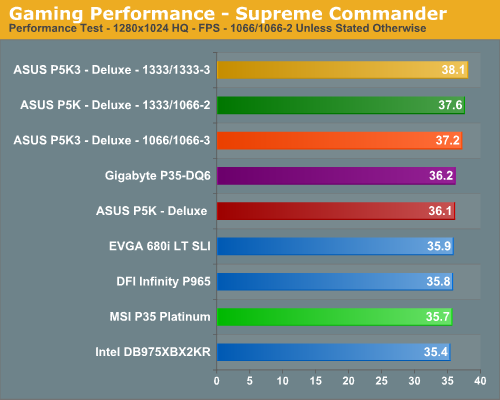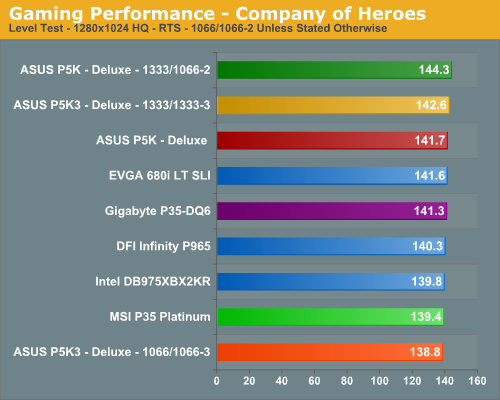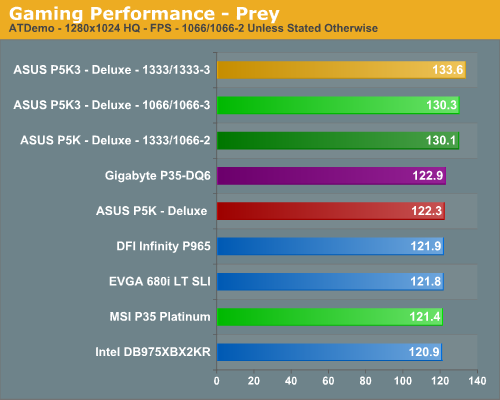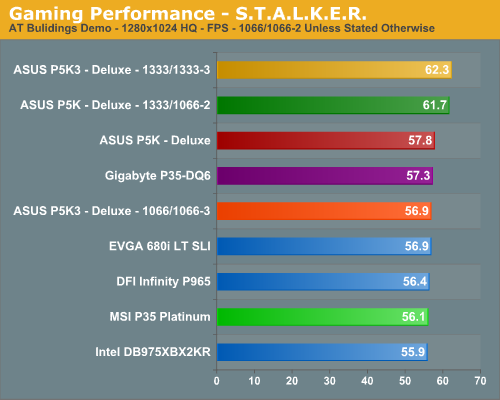Intel P35: Intel's Mainstream Chipset Grows Up
by Gary Key & Wesley Fink on May 21, 2007 3:45 PM EST- Posted in
- CPUs
Supreme Commander
Supreme Commander is one of the better RTS games to be released in recent memory although we are still huge fans of Command and Conquer 3 along with Company of Heroes. We chose Supreme Commander as it is both a GPU and CPU hog when it comes to systems resources. We utilize the built-in performance test to benchmark the game. We set all of the settings to high and only change the resolutions between benchmark runs. This benchmark provides a cornucopia of results but for our tests we will report the average frame rates during the benchmark. We generally find this game to be playable with frame rates at or above 35fps.
Company of Heroes
Company of Heroes was released last year and is still proving to be a very addictive RTS game around the office. The game is extremely GPU intensive and also requires a hefty CPU at times. If this is beginning to sound a lot like Oblivion, well CoH is very similar to Oblivion in system requirements. The visuals and audio experience within the game will at times have you believing the game is based more on a First Person Shooter than a traditional Real Time Strategy game. We set all options to High and turn on all additional video options.
The game contains a built-in performance test that utilizes the game engine to generate several different action scenes along with a coffee argument as a sideline distraction before the war starts. We found the performance test gives a good indication of how well your system will perform throughout the game on average. We have found some of the in-game action sequences to be more demanding than the performance test and are working on game play benchmark that is repeatable. We generally found the game to be enjoyable with an average frame rate above 35fps.

Prey
Prey offers some superb action sequences, unique weapons and characters, and is a visually stunning game at times. It still requires a very good GPU to run it with all of the eye candy turned on. We set all graphic settings to their maximum except for AA/AF and utilize a custom timedemo that takes place during one of the more action oriented sequences. We generally found the game to be enjoyable with an average frame rate above 35fps.

S.T.A.L.K.E.R.
S.T.A.L.K.E.R. is one of the favorite first person shooter games around the office as it continues to provide a great deal of replay value and the graphics are very good once the eye candy is turned on. What we especially like about the game is the atmosphere and the fact that it makes for a great system benchmark.

Gaming Summary
Once again the P35 boards, especially when operating at 1333 FSB, lead the pack although the differences overall are minimal when looking at the separation between boards except in Prey and S.T.A.L.K.E.R. Gaming continues to be driven by the GPU but every extra bit of performance always helps.










58 Comments
View All Comments
Gary Key - Tuesday, May 22, 2007 - link
The ICH8 only offered 4 SATA ports, ICH8R, DO, DH offered six. ICH9/R/DO/DH will offer six across the board. Once again, only the R/DO/DH will offer RAID. We should have some new Intel drivers this week to test that are suppose to increase performance a little more than what we noticed in testing.
Stele - Tuesday, May 22, 2007 - link
Ah yes, forgot about the li'l ICH8 Base :P Thank you!Based on recent findings mentioned in my post in response to yyrkoon above, there may not be any drastic changes to performance as the apparent implementation of command-based switching topology seems to apply only to ICH9's newly-added external port multiplier support. However, Intel might have tweaked the controller in ICH9 as they did to the DDR2 controller in the P35 MCH... and any performance increase is always welcome, all other things being equal :)
On a side note, I couldn't help but noticing on the Asus P5Ks the solderpads for a small IC and other discrete components just between ICH9 and the SATA ports. In fact, there are some interesting clues in the form of silkscreened labels on the PCB outlines near that area of the motherboard: "EZRAID_SET" on what looks like the PCB pads for a 3x3 jumper block, as well as "SATA_E2" on what looks like the pads for another SATA port, next to "SATA6/SATA_E1", the bottom left-most SATA port.
I'm guessing here, but that might be for a SATA to 2-port SATA port multiplier with software RAID functionality, or a SATA to 2-Port SATA storage controller with hardware RAID. We have encountered once such example of the latter before: the Asus P5W-DH's Silicon Image 4723 hardware RAID controller, aka ASUS EZ-Backup. The mode of operation is the same: take one SATA line from the ICH9 (SATA6 on the P5K) and split it into two, adding RAID features as well. That's why SATA6 was labelled as "SATA6/SATA_E1" on the motherboard - with the controller installed the SATA6 channel from the ICH9 would be rerouted to the controller which would then output to SATA_E1 and SATA_E2. The difference, I suspect, is that with ICH9's port-multiplier support, other devices can be used, including simple port multipliers rather than full-blown host-and-branch solutions.
Going one step further, I'm guessing that the mystery chip might be a http://www.siliconimage.com/products/product.aspx?...">Silicon Image SiI5723 storage processor. It's originally designed for eSATA, but that just means that its signal drive is sufficiently strong to span the 2m eSATA cables, and has hot-plug support; certainly can be used for internal SATA as well.
I made this guess based on several clues:
1. the PCB footprint for the mystery chip on the P5K seems to fit the package of the SiI5723 (QFN or Quad Flat No-lead)
2. the P5K's jumper block's complexity - a normal "Enable/Disable" block would only require a 3-pin jumper. Instead, a 3x3 block is seen here, which may be used for the "mode jumpers" referred to in the SiI5723's block diagram on its product page.
3. there seems to be a small SO-8 footprint between the jumper pads and the mystery chip, which would be just right for the "serial flash" firmware chip also referred to in the SiI5723's product page
4. Asus has a strong relationship with Silicon Image, having used their storage processors for a long time now, including the SiI3114 way back on the A7N8X Deluxe, the SiI4723 on their Digital Home series and currently the SiI3132 PCIe-to-2-port SATA for eSATA functionality on the high-end boards.
IMHO, Asus probably designed the option to have that controller in so that some RAID functionality can still be offered on a lower-end version of the board using the vanilla ICH9 (non-R) (the more likely scenario) and/or to allow for a Digital Home edition that provides for one more SATA port and one more RAID subsystem (instead of depending wholly on the Intel Storage Matrix). Just a thought!
yyrkoon - Tuesday, May 22, 2007 - link
Anyhow, the Asus boards, and the Gigabyte board all seem to use a secondary JMicron disk controller for the eSATA ports. My understanding is that all port multipliers need a SIL 3124, and in order to provide RAID need a SIL 3132 or greater chipset.According to the JMicron website, the JMicron JMB363 only supports command based switching.
http://www.jmicron.com/JMB363.html">http://www.jmicron.com/JMB363.html
Here is a link to SATA-IO's take on Port Multipliers:
http://www.sata-io.org/portmultiplier.asp">http://www.sata-io.org/portmultiplier.asp
If you NEED RAID using a Port Mulitplier, and you want a P35 based motherboard, perhaps ABIT will include a SIL 3132 secondary controller on one of their boards, as they have in the past. The only other company that uses SIL 3132 chips that I am aware of has been Asus, but it seems they've ditched it on these boards.
All that being said, it would probably be wiser to use a SAS controller with SATA drives anyhow. The expandability is much greater, and the flexability (depending on hardware) is also much better. Granted, hardware options right now are not all that great . . .
Stele - Tuesday, May 22, 2007 - link
Well no, a port multiplier is simply a mechanism for one active host connection to communicate with multiple devices. It therefore can be discrete, such as an SiI3726, or integrated into the host silicon - just as how network switch controller ICs can be discrete or integrated into, say, a gateway controller IC.Using a port multiplier does not mean you cannot use RAID - indeed, more often than not SATA controllers access an array through port multipliers (integreate on-silicon but sometimes discrete) for convenience - the IP blocks for a 2-channel host and a SATA-to-multiple-SATA multiplier can be separated or combined into various products.
Command-based switching is just a topology for the switching method, which allows commands to one drive at a time rather than arbitrated, aggregated access to any drive that is ready to perform I/O. However, it also doesn't mean that command-based switching thus cannot handle RAID, though it does mean that performance would suffer in a large array as the host would issue commands to only one drive at a time.
The Asus and Gigabyte boards continue their relationship with JMicron and the JMB363 for eSATA and PATA. Specifically, the JMB363 was there primarily for the PATA port missing from the 965 - the SATA ports are convenient extras that the manufacturers wisely chose to use as eSATA ports. Therefore there was no need for a further SiI3132 to provide the eSATA capability. On the other hand, the Asus Nvidia 6xx-based boards did not need the JMB363 thanks to Nvidia's retention of native PATA functionality; hence a separate, SATA-only solution was required for eSATA functionality - the SiI3132. On the P5K, we're back to the same situation as in the case of the 965 - no native PATA. Hence the JMB363 reappears to provide PATA and eSATA, negating any need for the SiI3132 once more.
What I was really referring to in my first post were changes (if any) to the internal design of the ICH9/9R based on the aforementioned news reports. After studying the ICH8 family's datasheet - which should not be too different from that of the ICH9 in this area - it appears that the ICH8 family did not support discrete port multipliers (which forms part of the AHCI 1.0 specs). What the news article would have meant, therefore, is that ICH9 now does support port multipliers - but only command-based switching types.
As for SAS...it is rather more complex and hence expensive to implement - design and manufacture - compared to SATA, and there really isn't a need for it in desktop systems now... as it is, Intel doesn't even want to implement FIS-based switching, so as to lower costs and complexity, let alone go to SAS. Coupled with this is the fact that most if not all SAS drives currently available are expensive enterprise-level products which, although fast, would most unlikely be found in the overwhelming majority of systems using this chipset. In the end, therefore, the SAS controller would end up having SATA drives plugged into it (provided board manufacturers remembered to use SFF 8482 connectors) in the majority of cases - further underscoring the waste of effort and resources in implementing an SAS controller into a desktop ICH now. There may be potential for SAS growth into the mainstream market in the future - especially when drives are more affordable and SAS scales up to its targetted 12Gb/s - but with new chipsets coming out every year or two, there's plenty of time to drop in SAS support later.
yyrkoon - Thursday, May 24, 2007 - link
Where you got 'using a port multiplier means you can not use RAID' I have no idea, that is not even close to what I said. Read again- more closely.Yes, you can use a discrete controller, capable of handling FIS based switching, and they are even fairly in-expencive. However, what does that have to do with these motherboards ? Nothing (other than MAYBE the boards bandwidth capabilities, which in this case is actually tied to the PCIe bus). That being said, you would not be loosing any bandwidth using a PCIe controller, because these JMicron controllers only use one 2.5Mbit PCIe lane.
Heh, and just because your hair may be on fire does not mean you need to put the flames out . . . Performance would be terrible.
Here, I see your lips moving, but I am not hearing one word. I think you kind of missed the point that SAS controllers not only are capable of controlling SAS drives, but are also capable of controlling SATA as well. AH, wait, I see now, but now you seem to think OEMs do not include a way to hook SATA drives up to a SAS controller ? And your counter point is what ? hooking up a Port multiplier in command based switching mode(for RAID) ? Yikes . . .
I have been following port multiplier technology now for a long time (since it started), and I have to say it is a very interresting technology. The only problem here is, that no one implements this technology the way it should be. Well, that is until the SAS specification came around, and then it is being driven by enterprise market, which is hell for desktop system users. In all seriousness, I can see using a port multiplier, even in command switching mode, but to claim you can RAID in command mode is rediculous. Can you do it? Sure, and you can even RAID USB keychains. Would you do it and expect to get decent performance ? No, not unless you had no clue. That being said, even is FIS command mode, you are still running fake RAID (software based RAID).
SAS now, with expanders, you can 'address' up to ~255 drives on a single controller, and with the right hardware, make Large arrays, that can litterally saturate two 3Gbit/s (768MB/s) ports. Now, you would need PCI-X, and you would most likely need server/heavey duty workstation hardware to get there. Do most of us need 255 HDDs ? No. DO most of us *need* more than ~100MB/s disk throuput ? No. DO most of us need Port Multipliers? No.The point however, is this: You *can* get a decent PCIe SAS controller for ~$300 usd, that supports large amount of disks if you need it, which means, instead of having to buy a new PM for each 5 drives, you only need to buy a expander for every 8(which by the way, you would have a hard time finding JUST an expander right now without a rack, or removable drive rack). Does the average user at home need 8 HDDs ? I do not know, but I personally have 2.1TB of storage im my home PC spanning 7 HDDs, and things are starting to seem crowded . . .
There are lots of ways of looking at this given situation, but the plain simple fact is : Most people do not need either a Port multiplier or an external SAS controller, but if I personally were to need more storage, you can bet I wouldnt be picking port multipliers over SAS, just because I thought I would be saving money (which, really is not as much savings as you may think).
yyrkoon - Tuesday, May 22, 2007 - link
Eh? Port Multipliers wont do any form of RAID without FIS based switching, perhaps I misunderstood your post ? According to the 'specification' only one drive at a time can be accessed, without FIS based switching.DigitalFreak - Monday, May 21, 2007 - link
There's no mention of the ICH9R on Intel's website (nor the P35 for that matter), so I doubt you'll get an answer until June.avaughan - Monday, May 21, 2007 - link
Good to see people starting to benchmark on Vista.Now that drivers are (hopefully) starting to mature, any chance of benchmarks of Winxp v Vista 32bit v Vista 64bit (all on the same hardware)?
Gary Key - Tuesday, May 22, 2007 - link
I lost what little hair I had testing under Vista 64, however, we are going with it from here on out. ;-) We will do a OS comparison in a month or so, waiting on ATI to get the performance drivers out for the R600 this week. The release candidate betas already have some significant improvements in OpenGL, CrossFire, and overall compatibility.bnathuat - Monday, May 21, 2007 - link
What is the bracket for Q3? I'm looking to build a new PC after July 22nd. Will the X38 chipset be ready by then? Sorry for the noobish question